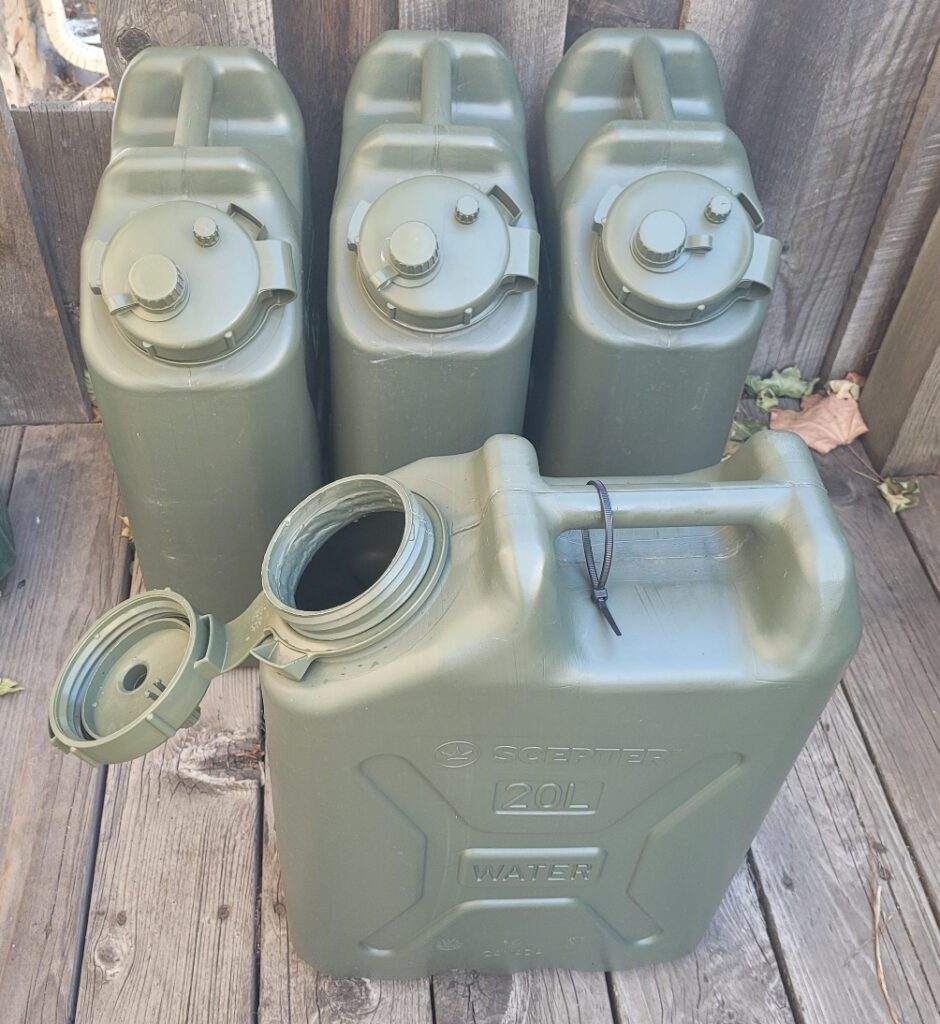A few posts back I mentioned that I had bought a new bunch of Scepter water cans.
 Any new plastic container is going to have ‘that plastic smell’. Also, you don’t know where that container has been or what its been exposed to in its time at the warehouse. So, the smart survivalist will clean these things out if for no other reason than to at least get rid of that unappealing strong plastic smell.
Any new plastic container is going to have ‘that plastic smell’. Also, you don’t know where that container has been or what its been exposed to in its time at the warehouse. So, the smart survivalist will clean these things out if for no other reason than to at least get rid of that unappealing strong plastic smell.
Ten bucks up at CostCo gets you about 14# of baking soda. You don’t need 14# of baking soda to wash out a water jug, but more is better, right? I err on the side of overkill, so I fill a gallon pitcher with hot water, dump in about a cup of baking soda, stir well and dump it into the water jug. Seal it up loosely so water can escape a bit and get the threads of the cap. Shake vigorously, shake some more, and then finally shake it vigorously. I give it about 30 seconds of violent shaking so I can feel the water hitting all the sides of the jug. Don’t be gentle.
Now, if you’re just doing one jug, you can dump out the mix and then rinse the thing out thoroughly with cold water from a hose. But, since I’m doing more than one, I’ll dump the mix into the next jug and repeat the process. I’ll do this for two or three jugs and then use some fresh baking soda/water mix.
Keep in mind, when you dump the water/soda mix out of the jug it will leave traces of baking soda on the inside that will eventually dry to a powdery film. This is why the rinse with clear cold water afterwards.
By this method I either totally eliminate the plastic smell, or reduce it to virtually nothing. And, of course, I’ve now cleaned out the inside of the jug. If you’re a suspenders-and-a-belt guy you may want to disinfect or sterilize the jug afterwards. Thats pretty much the same process but using water/bleach instead of water/baking soda.
And, finally, when it’s time to fill these things you can add all sortsa ‘water preservers’ or bleach to promote storage life. Its my understanding that municipal water (“city water”) is fine to store right out of the tap since it has already been treated by the municipal water provider.
I should also point out that I do this for any large plastic container that I am storing something edible in. My buckets for rice, wheat, etc., also get this treatment. In that case it is imperative that you make sure the bucket is completely bone dry before you fill it with your food product. After cleaning I usually let the bucket/container sit in a dry place indoors for a few days to completely dry out.
Can I get away with not doing any of that and just fill the things up without going through that effort? Absolutely. But this is stuff you’re putting away for a rather dire circumstance. When that dire circumstance occurs (or is occurring) aren’t you going to want every confidence and advantage possible? Of course you will…so spend the ten minutes and do the work. Future you will thank you.


I do the water/bleach thing on water cans and 5 gallon food safe buckets then take out the top rack in the dishwasher, put a bucket on the lower rack (or 2 Scepters), turn the tankless up to 135F, drop in a dishwasher soap tablet and run it on the “heavy and sanitize” cycle, then set aside to dry.
How can you be sure that the interior of the Scepter cans get cleaned and sanitized in the dishwasher?
I was looking at these cans on their website. They list Lowes as a seller. The civilian are 30 bucks and the military grade are 54 bucks. Do you think there is that much difference in quality?
Couldnt tell you, I only have the military ones…nothing to compare against. I’d like to think that for that kind of difference there’s some advantage.
ok. thanks.
Whether or not you can directly store municipal water depends on local treatment (or lack thereof).
I used to work in an office that had an ongoing dispute with the water system because our water didn’t meet state standards.
Public water systems all have public data – look it up; some systems are really good and some are horrendous!
I’m curious what your water to bleach ratio is for storage. Especially for well water.
Add some white vinegar to that baking soda and water mix. The vinegar will also remove any foul smells and is a great cleaner. When you’re done cleaning the jugs/barrels, use the remaining liquid to soak and clean your 90% silver stack.
Last I checked, doesnt adding vinegar to baking soda cause a rather startling reaction?
Yep, you’re making carbon dioxide and sodium acetate. I’d rinse 3 x with vinegar, 3x with baking soda, and 3x with plain water.
The reaction is a little foaming that helps with the cleaning process.
Many years ago, I purchased two soft drink syrup 55 gallon barrels for $10 each, locally picking them up from a garage sale. Split a gallon of bleach between them then added about four or five gallons of water inside them. Closed them up and then rolled them around to distribute the contents into every crevice / seam of barrel. Drained them, then only city water and rolled again to rinse out. Drained them again, hung them upside down to dry and called it good.
Were they good – HellifIknow, I never used the drinking water stored inside. Kept in the garage until Mom threw them out about 10 years ago without telling me.
Following. The extra work and sanitation steps in set up and storage of water / containers is important to eliminate possible baddies in the stored water and having properly prepared containers. Doing all these steps and work on an otherwise lazy day or weekend during our current gravy times will pay off when the spaz out starts and you will be then quite busy with other things. The military grade, or spec type water cans from .gov contractors with nsn numbers, or imports from reputable military type sources is preferred. The durability and specs required by uncle sam or allies, ensures a better product than any commercial happy camper versions out there. The durability is highly necessary for transporting and cargo hazards, as well as storage in austere or primitive scenarios, plan for all contingency scenarios. Water that is cached away clean and safe for consumption will be as necessary as those rifles come spicy times.
Staying hydrated thus staying frosty….
I can attest to the durability if the Spectre water jugs, never really saw one destroyed. You would probably have to run it over with a 5 ton,humvee wouldn’t bother it. Desert trick,leave them in the sun then sleep on them to stay warm(warning everything else wants to stay warm so you will wake up to snakes,scorpions, lizards and other undesirable bunk mates. In winter conditions place underhood of 5 ton and it won’t freeze when you start the engine regularly to prevent cold start
https://www.youtube.com/watch?v=XwUkbGHFAhs. After WW1 German army said, “We need a better way to transport gasoline.” Here ya go.
https://www.commanderzero.com/?p=9186
Quick word of warning: Be careful using a garden hose to fill up potable water containers. Wound up with a lovely case of dysentery once due to some bad bugs hiding in a hose.